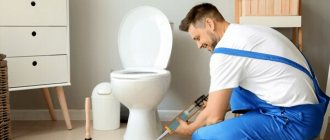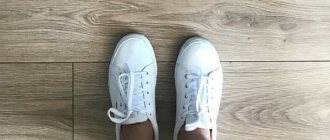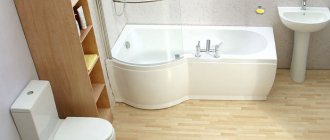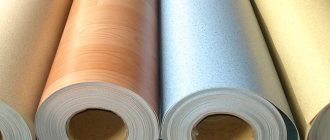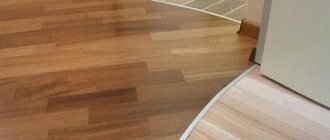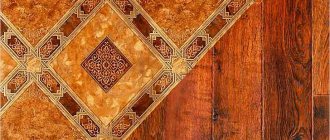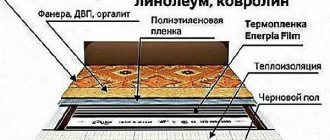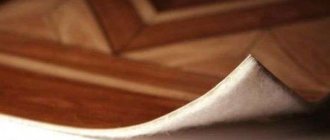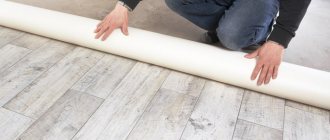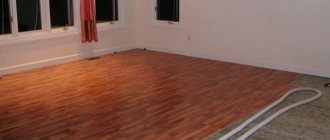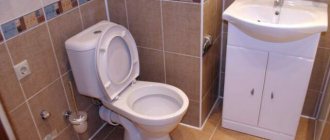The variety of types of linoleum allows it to be used for different purposes. Linoleum often becomes the basis in home interior design, as well as in commercial buildings. In most cases, this coating refers to rolled PVC coverings, while natural linoleum occupies only a small share of the flooring materials market. PVC linoleum has high aesthetic and quality characteristics. And if all the nuances of installation technology are observed, the coating acquires a long service life.
One of the most important questions that arises before installation:
Is it necessary to glue linoleum?
Note
Those who risk laying the covering without fixing it face:
- fungus formation
- waves on the carpet,
- bubbles with folds,
- damage when moving furniture.
If we consider harder PVC coatings, then unevenness and swelling can be observed in those places where the coating does not have a strong bond with the base. Such areas are the first to suffer from wear and tear.
Soft household coverings are subject to change in size due to fluctuations in humidity and temperature. During the winter season, when the rooms are heated, linoleum shrinks. If the coating is not glued, then gaps will form between the joints. With the onset of spring and increased air humidity, the linoleum stretches again and then bubbles appear on the surface, which are almost impossible to fight.
To avoid defects when installing the floor covering, it is recommended to use the adhesive method.
Advantages of adhesive installation
The main types of linoleum used in construction are polymer or natural roll coverings. For laying both of them, glue can be used as a finishing coating on the floor.
Adhesive flooring
Advantages of adhesive installation:
- reliable adhesion of the finishing material to the base;
- imparting overall strength to the coating;
- eliminating the risks of displacement and deformation of the canvases under dynamic loads on the floor;
- increase in service life;
- high-quality joining of roll sheets;
- reduction in the time of natural shrinkage (change in length) of canvases.
- reducing the value of residual deformation (memory) of linoleum under point influences;
- increasing resistance to moisture on the inner layers of the fabric.
The widespread belief that by laying linoleum on the floor without glue, you can reduce material costs, is not always confirmed by reality. The increased service life of the glued coating more than compensates for the cost of glue
Consequences of dismantling linoleum using glue
The only disadvantage of adhesive flooring is the impossibility of maintaining all the performance qualities of the coating for its further use in the event of dismantling.
How to choose glue for linoleum?
When selecting glue, you should pay attention to:
- type of base
There are two types of bases - absorbent and non-absorbent. Absorbent materials include concrete, wood, cement screed, gypsum screed, chipboard, fiberboard. Non-absorbent materials include old linoleum, PVC coating, laminated parquet, ceramic tiles, marble, granite, metal and various polymer coatings.
To determine the type of base, perform a simple test. Drop some water on the floor and see if it is absorbed or not. Carry out the test even if you are sure of the type of base. For example, treating a loose base with a film-forming primer turns it into a non-absorbent one. It is quite difficult to determine this visually.
- type of coating
Household (heterogeneous) coatings have a heterogeneous structure, several layers and retain their appearance for a long time; the thickness of the protective layer varies from 0.12 to 0.3 mm. They are used in low-traffic areas, such as bedrooms and living rooms.
Commercial (heterogeneous and homogeneous) coatings are much more resistant to stress. The thickness of the protective layer of such materials is already more than 0.4 mm. Coatings are used in corridors due to high traffic and in any commercial facilities such as offices.
Advantages and disadvantages
Welding is chosen when they are renovating a home and want to ensure that the linoleum seams on the floor are not visible to the naked eye.
Advantages
- Gluing the canvases is done quickly and with a high-quality result.
- No auxiliary tools needed. Everything you need is included with the adhesive. You may only need double-sided tape to cover the joints.
- The cost of the work will be low both for gluing new flooring material and for working with the old coating.
- The junction of the canvases will be almost invisible, visually it will look like ordinary linoleum.
Flaws
- High toxicity. The product contains components harmful to humans. Work with the mixture is carried out in a respirator. It is necessary to check the composition's compliance with all standards.
- Limited use. Only single-layer material can be soldered by welding. When gluing multilayer linoleum, the seam will be rough and very prominent. Welding is not recommended if insulation is placed under the main covering or the material has a felt base.
Many manufacturers produce glue for linoleum joints. Most of them will have a similar list of components.
- Solvent. More often it is tetrahydrofuran containing chlorine, which affects PVC, melting it. The component has practically no effect on other types of linoleum. This must be taken into account when choosing an adhesive, because manufacturers can add other polyurethanes to the flooring instead of polyvinyl chloride.
- Filler. Often this is PVC in liquid form.
The characteristics and types of mixtures may differ due to different ratios of elements in the composition. For example, type A has more solvent than type C, and type C has a much higher percentage of PVC.
There are 3 types of welding mixtures, differing in consistency. To choose the composition, consider the width of the gap between the parts of the material being glued.
Adhesives for PVC coatings are divided into groups:
- Adhesives for continuous bonding
Water-dispersed compositions are the most common today - they are universal for laying most types of coatings and, in addition, are absolutely safe. Such compositions are applied directly to the base. This technology requires less time and less glue.
The recipe for adhesives depends on their specialization. For coatings with special properties, the adhesive composition is noticeably different. For example, adhesives for conductive coatings not only perform adhesion functions, but also form part of the conductive system. When working with PVC tiles, a special adhesive is required, which allows for a longer open installation time. And if the composition turns out to be insufficiently heat-resistant, then with increasing temperature and mechanical loads, the joints of the tiles may become detached from the base.
- Adhesives for fixation.
Unlike adhesives for continuous gluing, fixing compounds have average adhesive ability and at the same time high permanent stickiness. Used for laying PVC tiles and modular carpet tiles. The fixation is applied with a roller, which is much easier than applying with a spatula, and does not require additional skills. The clamp allows you to easily dismantle sections of the coating. Due to this property, such compositions have become popular primarily in offices and rented premises. Quick removal of a section of coating provides quick access to communications and allows you to save on repairs. After all, at any time the tile can be replaced with a new one.
How to glue linoleum to a concrete base
The concrete surface should be cleaned with a vacuum cleaner, cracks and irregularities should be covered. To glue linoleum to concrete, we recommend pre-treating the base with a primer for better adhesion.
Gluing linoleum to a concrete base at home is not difficult. It is enough to follow all the principles of technology. The room where the work is carried out must be well checked, the temperature is not lower than 15°, and the humidity is within 5-10%.
The glue is selected taking into account the primer. When treating the base with a film-forming primer, the adhesive composition should be selected for a non-absorbent base.
Installation of antistatic material and requirements for it
Since the conductivity of this material differs in any position, special attention should be paid to the thickness of the floor covering and the quality of its installation. Even a damp environment is not considered as dangerous in terms of electrical voltage distribution as the thickness and quality of the laid flooring. This means that in places with a distinctive thickness, the resistance of the material will also change, which in turn will affect the quality of the base on which the antistatic flooring will be laid.
When performing preparatory work, it is important to strictly observe the reliability of contact between the coating and grounding. In this case, the “ground” is a copper strip. A special conductive adhesive is also used, the characteristics of which we discussed earlier.
Before laying, the sheets are placed on a flat floor. All so that the material used can get used to the new position. I would like to note that it is necessary to comply with the recommended microclimatic conditions. For example, temperatures should be within +18 degrees Celsius, and humidity should be no more than 60 percent.
Important! When purchasing material of this kind, it is extremely important to carefully inspect it so that there are no folds or dents. In this case, after installation you may have significant problems. After all, there is no talk about aesthetic issues at all.
How to glue linoleum to OSB (OSB) board
The main property for which OSB boards are loved by installers is their strength. It is also an excellent material for leveling the floor.
Oriented strand board is an absorbent substrate. Homakoll 208, Homakoll 228, Homakoll 248 adhesives are suitable for laying rolled linoleum.
Putty is recommended only for joints and screw fastenings.
Cold welding concept
This is a simple method of joining two strips of linoleum. It is carried out with an adhesive composition.
Cold welding adhesive works on the principle of a solvent, which “melts” the edges of the floor covering. Liquid linoleum on both sides at the junction reliably and firmly connects them to each other, forming a thin, almost imperceptible seam after cooling. You can weld joints of any width. The formed seams will have the same characteristics and elasticity as the main linoleum sheet.
The glue is very toxic, so all actions must be carried out in compliance with safety precautions. Personal protective equipment is used.
How to glue linoleum to a wooden floor
The gluing technology is no different from previous ones. The most important thing is to level the wooden floor and clean it thoroughly. Any water-dispersed adhesive for absorbent substrates can be used as an adhesive composition. Also suitable are universal adhesives homakoll 208 and homakoll 164 prof with increased stickiness, regardless of what primer the base is coated with.
Summarize
Based on the results of the article, we can conclude that it is possible to glue new linoleum over the old one, and you can do this on your own without the involvement of specialists. Now you know how to glue one canvas to another, and that there are adhesive compounds that can harm a person.
But in order to get a high-quality result of your installation work, it is important to choose the right adhesive composition, which is primarily responsible for the long-lasting service of the coating. If you don’t know which glue to choose, you can always turn this question to a specialist who will definitely advise the right option, because not every composition is capable of providing high adhesion to a particular base.
We hope that our article and detailed instructions about the process of installing a new coating over the old one will be useful to you, and you will get a high-quality result and new linoleum for a long time.
How to glue linoleum to fiberboard on the floor
Fiberboard is an excellent underlay that is often used to level floors. If the room is dominated by dry air and there are no temperature fluctuations, then this coating will be a good base for linoleum. And considering that fiberboard is easy to install and has a low cost, we can safely say that this material is a favorite among installers.
To glue linoleum to fiberboard, use the universal adhesive homakoll 164 prof with increased stickiness and long open working time, or the more economical homakoll 208. And in rooms with high traffic, you can use adhesive for semi-commercial linoleum homakoll 248.
All of them have a thick consistency and are conveniently applied with a spatula.
What is the difference between hot and cold welding methods?
The last category of materials is held together by hot welding, carried out using specialized equipment capable of heating up to 400ºC. At the junction of the pieces, first make a groove for the lace. The latter is secured in a welding gun, which makes it possible to quickly insert the cord into the groove. Under the influence of elevated temperature, the cord melts and holds the coating together at the joints. After cooling, the seam is sanded.
As you can see, the process is quite labor-intensive. The hot welding procedure can be simplified by using Homakoll commercial linoleum adhesive. Its price is affordable for most consumers. The drug has many valuable characteristics. The composition contains resins and a water-polymer dispersion, the viscosity is 40,000...85,000 mPa/s, the density is 1.5 g/cm3. Consumption depends on the type of base: for priming a prepared surface - 200 g/m2, for an unprepared surface - 700 g/m2. Khomakol linoleum adhesive is recommended for laying commercial-type polyvinyl chloride products on substrates such as cement, concrete, and wood.
When applying household type linoleum, cold welding adhesive is used. For freshly laid canvas, it is necessary to purchase an adhesive preparation of grade “A”. The cost of such a product is 55...58 ml per 25 m of seam with a thickness of 3 mm. To fasten a seam in old material, you will need grade “C” with a thick consistency. Before starting work, the edges of the coating are secured with tape. It is cut and glue is poured in to weld the polymer material. 10 min. Afterwards, the tape is removed along with the remaining adhesive. The result is a neat seam.
For any category of flooring, you should purchase a special adhesive, taking into account the above factors. Professional builders recommend using Tarkett linoleum adhesive for installation. It should be taken into account that this product is produced in two versions: for industrial and household use.
There are other types of adhesive compositions on the market, both universal and taking into account the individual physical and technical characteristics of the flooring. When purchasing glue for linoleum, you must carefully read the instructions that are included with it.
How to glue linoleum to plywood
Any base under linoleum must be strong, level and dry. Laying sheets of plywood is often chosen as one of the methods for leveling the floor. After installation, the plywood is sanded to remove burrs, the screw heads are puttied, as well as the seams between the panels.
With proper preparation of plywood sheets, the base becomes durable and moisture resistant. After cleaning the base, the linoleum is spread and left for 2 days to acclimatize.
A suitable adhesive for gluing linoleum to plywood is a water-dispersible adhesive for absorbent substrates.
Required Tools
Whether it is necessary to glue linoleum - each owner decides based on personal considerations and the technical characteristics of the room. Based on this decision, the foundation will be prepared. To conveniently lay and properly glue linoleum, the master will need a number of the following tools:
- roulette;
- masking tape (and double-sided);
Styling tools - marker;
- knife;
- notched spatula;
- long screws;
- belt grinder;
- dense rubber roller;
- scissors large and small;
- metal ruler;
- glue and rubber gloves (respiratory mask).
Particular attention should be paid to the glue: the entire result of the repair will depend on it. To decide what is better for gluing linoleum, you need to pay attention to the type of material and type of floor.
Watch the video to know about the tools:
How to glue to old linoleum
Installation of linoleum should be carried out on a rigid, level base. And for this case, old linoleum will not be a completely suitable substrate, since the material is flexible and soft. We recommend that you first dismantle the first layer, prepare the base, and then lay a new one. Laying linoleum on an old coating risks the formation of mold and repetition of the defects of the previous layer.
The practice of laying linoleum on linoleum still exists. If you still decide to do this, make sure that your coating has not lost its elasticity and is not damaged, otherwise the coating should definitely be dismantled.
For gluing linoleum, glue for non-absorbent substrates is suitable, for example, homakoll 268 for residential sectors and homakoll 164 for commercial sectors.
Is there a difference between gluing linoleum in an apartment and in a country house?
In country houses in rooms with high traffic, such as the kitchen and corridor, it is advisable to use linoleum of at least class 32, which is much more resistant to various mechanical influences. Homakoll 248 or Homakoll 148 is used with this coating.
For bedrooms, household linoleum in combination with homakoll 208 and homakoll 268 glue is suitable.
Useful tips
Algorithm for performing operations:
- Linoleum is laid out for acclimatization for 1-2 days;
- the base is prepared (cleaned of dust and dirt, cracks are sealed, the surface is leveled);
- primer is applied;
- linoleum is cut in place (leaving gaps around the perimeter between the canvas and the walls);
- linoleum is glued;
- pressed and smoothed (to remove air). Adhesive compositions must reliably fix the linoleum, prevent it from shifting, the appearance of fungus, bubbles, ensure the removal of the coating (if necessary) and not destroy the base.
Common mistakes when gluing
Incorrect gluing leads to poor-quality repairs. If the master does not follow the work algorithm, he has to figure out why the linoleum moves in waves and does not stay in place.
There are several reasons. This may be a poor-quality composition that no longer provides strong adhesion. Other problems may arise due to the fact that the surface was not properly cleaned before gluing. Any dirt or dust impairs adhesion and prevents the materials from bonding tightly.
Masters advise following these working rules:
- you need to work in rubber or latex gloves;
- it is advisable to use a mask or respirator;
- the adhesive seam must be uniform;
- there is no need to quickly remove excess - it is better to wait for the seam to dry completely so that it does not peel off;
- Having chosen the cold welding method, you need to make sure that the composition is driven deep into the seam.
